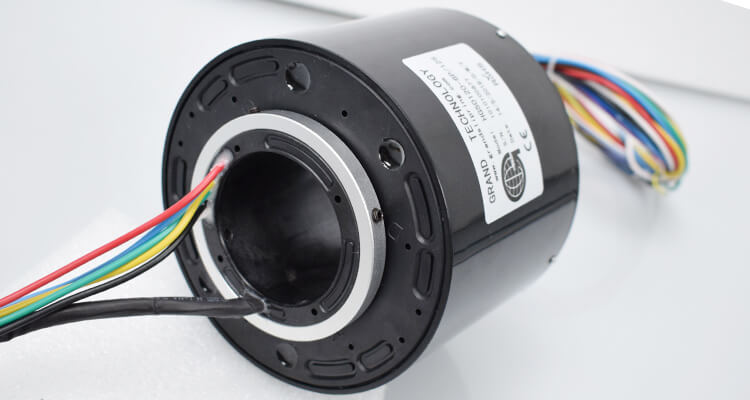Low voltage slip rings, as the name implies, are engineered for applications that demand lower voltage levels. Far from being lesser versions of their higher-voltage counterparts, these specialized variants offer a unique set of features and characteristics uniquely suited for low-voltage systems.
At the heart of every low-voltage slip ring is its mission: to provide a reliable, low-resistance electrical connection between stationary and rotating parts while maintaining minimal voltage variation. This precise form of power or data transmission caters to a vast array of applications across different industries. More specifically, these slip rings are hailed for their ability to enable motion and data transfer, overcoming the limitations traditionally associated with rotating interfaces in low-voltage operations.
Conceptually, low-voltage slip rings mirror their counterparts. However, they are distinctly defined by their compatibility with low-voltage applications, typically ranging from millivolts to just under 50 volts.
Designed meticulously with high-grade materials and cutting-edge technology, these slip rings serve a multitude of functions across disparate industries. From optimizing performance in the high-speed robotics industry and managing communication and control systems in aviation to aiding energy generation in wind turbines and enhancing operations in manufacturing industries, low-voltage slip rings have found esteem and value.
In essence, low-voltage slip rings epitomize the fusion of efficiency and innovation. They excel where conventional slip rings falter, offering reliable, efficient, and safe solutions for the management of power and data in low-voltage applications. The low voltage slip ring’s unique adaptability makes it an indispensable versatile tool, engaging effectively within the dynamic world of modern industry.
Low Voltage Slip Ring Key Components and Functionality
Low-voltage slip rings are a marvel of simplicity and precision. Though their design may vary somewhat based on the specific needs of each application, the basic structure primarily consists of three key parts: the rotating contacts (slip ring), stationary brushes, and housing.
The rotating contacts are typically discs or rings made from conductive materials that rotate with the device, carrying the power or signal. These contacts rotate around the central axis of the device, typically attached to the machine’s moving part requiring power or signal.
The stationary brushes, on the other hand, stay put in one position. Made from various conductive materials, including precious metals for superior conductivity and minimal electrical noise, brushes make contact with the rotating ring. They are often designed to exert consistent pressure on the ring across the entire rotation, ensuring a stable electrical connection throughout.
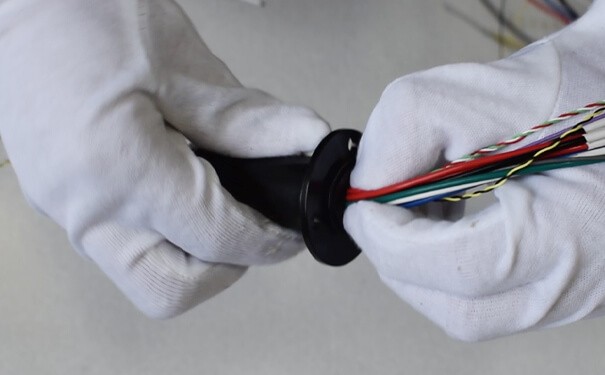
The housing is the component that safeguards the internal parts of the slip ring assembly from environmental factors dust and damage. It is typically constructed from robust materials to ensure the longevity and reliability of the system.
When it comes to operation, low-voltage slip rings operate based on creating a continuous electrical path between the stationary and rotating parts. As the rotating section of the slip ring spins, the brushes maintain continuous contact with the ring. This contact enables the transfer of electrical power or signals from the stationary structure to the rotating part (or vice versa), all while the device is in motion.
What truly sets low voltage slip rings apart is the attention to detail to maintain consistency and reliability of electrical transfer at lower voltages. The choice of materials for the ring and brushes is often more critical, as they must ensure minimal resistance and electrical noise. Moreover, the design of housing, brushes, and contacts is fully optimized to sustain effective operational capacity even under low voltage conditions, maintaining signal integrity and reducing any chances of signal loss or degradation.
In demonstrations of coherent yet simple functionality, low-voltage slip rings provide an effective solution to the age-old challenge of transferring power or signals in a rotating assembly, shining as an epitome of technological prowess.
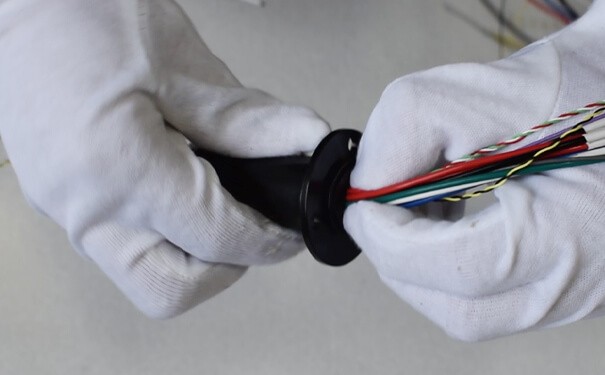
Key Components of Low Voltage Slip Rings
- Rotor (Rotating Part)
- Functionality: The rotor is the moving part of the slip ring, designed to rotate with the machinery. It contains the conductive rings (often made of copper or another conductive metal) which are electrically connected to the rotating circuits or components.
- Importance: It facilitates the transfer of electrical signals and power from the stationary part to the rotating part without any interruption.
- Stator (Stationary Part)
- Functionality: The stator remains fixed and does not rotate. It houses the brushes or contacts that press against the rotating conductive rings of the rotor.
- Importance: It provides a stable point of contact for electrical connection to the external circuits and power sources.
- Brushes or Contacts
- Functionality: These are typically made of conductive materials such as graphite, precious metal alloys, or copper. They maintain a constant sliding contact with the conductive rings on the rotor.
- Importance: They ensure a continuous electrical connection as the rotor spins, allowing for uninterrupted power and signal transmission.
- Conductive Rings
- Functionality: These rings are embedded in the rotor and are connected to the electrical circuits of the rotating part. Each ring corresponds to a specific electrical path.
- Importance: They provide a surface for the brushes to contact and facilitate the transfer of electricity from the stationary to the rotating parts.
- Housing
- Functionality: The housing encloses the rotor, stator, brushes, and rings, protecting them from environmental factors such as dust, moisture, and mechanical damage.
- Importance: It ensures the durability and longevity of the slip ring by providing a controlled environment for its operation.
Functionality of Low Voltage Slip Rings
- Electrical Signal Transmission
- Slip rings enable the transfer of electrical signals, such as control signals, data, and low-power electrical signals, across a rotating interface. This is essential in applications like robotics and medical equipment where precision and reliability are crucial.
- Power Transmission
- Low voltage slip rings are designed to transmit electrical power at lower voltages (typically up to a few hundred volts). This is important for applications like wind turbines, rotating stages, and CCTV cameras, where power needs to be delivered to rotating components.
- Uninterrupted Rotation
- One of the primary functionalities is to allow for continuous 360-degree rotation without any interruption in the electrical connection. This eliminates the need for fixed wiring, which would otherwise twist and eventually break.
- Low Maintenance
- Designed for durability, slip rings require minimal maintenance. The brushes and conductive rings are engineered to withstand wear and tear, providing long service life and reliability in demanding applications.
- Signal Integrity
- Low voltage slip rings are built to maintain high signal integrity, ensuring that the transmitted signals are not degraded. This is critical in applications where accurate and reliable data transmission is required, such as in medical imaging devices and communication systems.
By understanding these components and their functionalities, one can appreciate the critical role low voltage slip rings play in various modern technologies, ensuring efficient and reliable operation in rotating systems.
Low Voltage Slip Rings Working Principle
- Electrical Contact:
- The brushes are in constant contact with the rotating slip ring.
- As the rotor rotates, the brushes slide over the conductive rings embedded in the rotor.
- Signal Transmission:
- Electrical signals or power are introduced to the slip ring through the brushes.
- The conductive rings on the rotor transmit these signals or power to the corresponding circuits on the rotating part of the machinery.
- Continuous Rotation:
- Despite continuous rotation, the slip ring ensures an uninterrupted electrical connection.
- This allows for the transmission of power and signals without the need for fixed wiring, which would otherwise twist and break.
Applications of Low Voltage Slip Rings
Low voltage slip rings are essential components in various applications where electrical signals and power need to be transmitted between stationary and rotating parts. Here are some key applications:
- Function: Transmit power and signals between the stationary nacelle and the rotating blades.
- Importance: Essential for controlling blade pitch and monitoring system performance, ensuring efficient and reliable energy production.
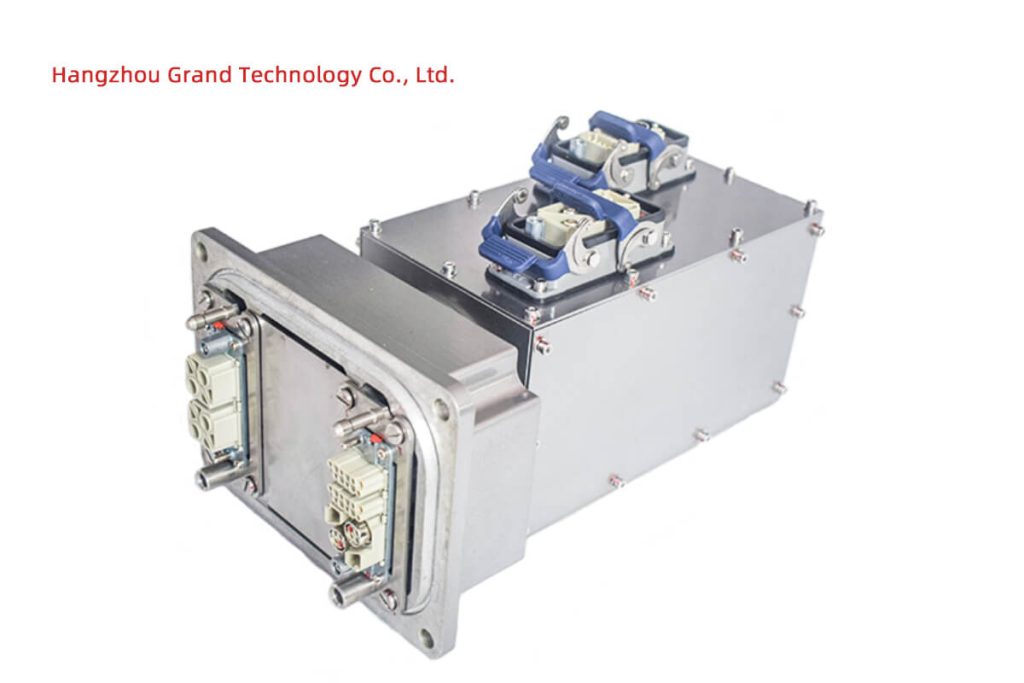
wind turbine slip ring
2. Medical Equipment
- CT Scanners and MRI Machines:
- Function: Transmit power and data to the rotating imaging components.
- Importance: Enables high-speed imaging and precise control of imaging equipment, improving diagnostic capabilities.
3. Robotics
- Industrial Robots:
- Function: Provide power and control signals to rotating joints and sections.
- Importance: Ensures continuous operation and precise movement control, enhancing automation efficiency.
4. Surveillance Systems
- Pan-Tilt-Zoom (PTZ) Cameras:
- Function: Allow continuous rotation and tilt of cameras while transmitting power and video signals.
- Importance: Provides seamless and uninterrupted surveillance capabilities.
5. Rotary Tables
- Manufacturing and Assembly Lines:
- Function: Supply power and control signals to rotating workpieces or tools.
- Importance: Enhances the flexibility and efficiency of manufacturing processes.
6. Aerospace and Defense
- Radar Systems:
- Function: Transmit signals between stationary platforms and rotating antennas.
- Importance: Ensures accurate and reliable operation of radar systems for navigation and tracking.
7. Packaging Machines
- Function: Provide power and signals to rotating parts of Packaging machinery.
- Importance: Facilitates efficient and continuous packaging processes, improving production rates.
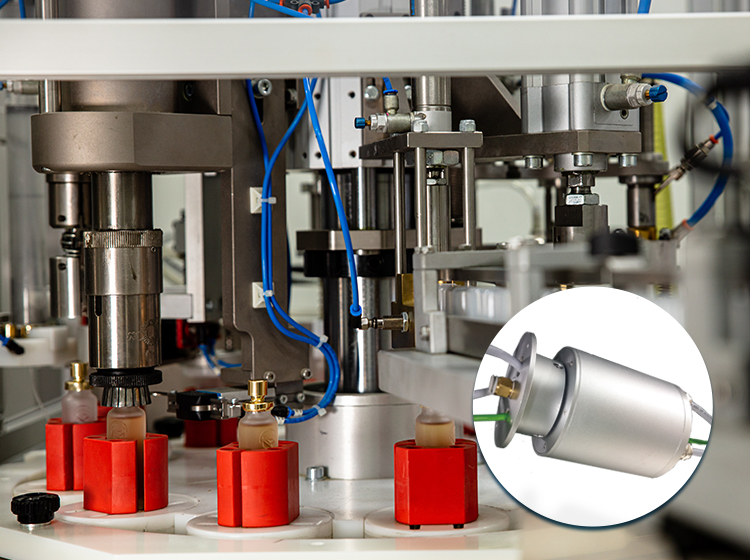
8. Amusement Rides
- Function: Transmit power and signals to rotating components of amusement rides.
- Importance: Ensures safe and reliable operation of rides, enhancing user experience.
9. Marine Applications
- Rotating Cranes and Winches:
- Function: Supply power and control signals to rotating machinery on ships and offshore platforms.
- Importance: Facilitates efficient handling of cargo and equipment in marine environments.
10. Renewable Energy Systems
- Solar Trackers:
- Function: Transmit power and control signals to rotating solar panels.
- Importance: Optimizes the orientation of solar panels to maximize energy capture.
11. Telecommunication
- Rotating Antennas:
- Function: Ensure continuous transmission of power and signals to rotating communication antennas.
- Importance: Enhances the reliability and performance of telecommunication systems.
12. Test Equipment
- Rotary Test Stands:
- Function: Provide power and signals to rotating components under test.
- Importance: Facilitates comprehensive testing of rotating machinery and components.
13. Mining and Drilling Equipment
- Function: Supply power and control signals to rotating drills and excavation machinery.
- Importance: Enhances the efficiency and safety of mining and drilling operations.
Low voltage slip rings are integral to these applications, ensuring continuous and reliable transmission of power and signals, which is essential for the efficient and safe operation of various rotating systems.

Advantages of Low Voltage Slip Rings
Low voltage slip rings offer several advantages, making them indispensable in various applications where electrical signals and power need to be transmitted across rotating interfaces. Here are some of the key advantages:
1. Continuous Rotation
- Benefit: Enables 360-degree continuous rotation without interruption.
- Importance: Critical for applications requiring seamless operation, such as wind turbines, rotary tables, and PTZ cameras.
2. Uninterrupted Power and Signal Transmission
- Benefit: Maintains a consistent electrical connection between stationary and rotating parts.
- Importance: Ensures reliable operation of machinery and equipment, preventing downtime and maintaining productivity.
3. Durability and Low Maintenance
- Benefit: Constructed with robust materials and designed for long-term use.
- Importance: Reduces the need for frequent maintenance, lowering operational costs and increasing the lifespan of the equipment.
4. Versatility
- Benefit: Can handle various types of signals, including power, data, and control signals.
- Importance: Suitable for a wide range of applications, from industrial machinery to medical devices and renewable energy systems.
5. Compact Design
- Benefit: Often designed to be compact and space-efficient.
- Importance: Fits into limited spaces within machinery, making it ideal for applications with size constraints.
6. High Signal Integrity
- Benefit: Maintains the quality and integrity of transmitted signals.
- Importance: Essential for applications requiring precise and accurate data transmission, such as medical imaging and telecommunications.
7. Customizability
- Benefit: Can be tailored to specific application requirements, including the number of circuits, type of signals, and environmental conditions.
- Importance: Provides flexibility to meet unique operational needs and enhance performance in specialized applications.
8. Cost-Effective
- Benefit: Offers a cost-efficient solution for transmitting power and signals in rotating systems.
- Importance: Reduces the need for complex and expensive alternatives, contributing to overall cost savings in equipment design and maintenance.
9. Enhanced Safety
- Benefit: Reduces the risk of electrical faults and mechanical failures.
- Importance: Ensures safe operation in critical applications, such as medical equipment and aerospace systems.
10. Improved Efficiency
- Benefit: Optimizes the performance of rotating machinery by providing a reliable electrical connection.
- Importance: Increases the efficiency and effectiveness of industrial processes and equipment.
Application-Specific Advantages
- Wind Turbines: Enhances energy production efficiency by enabling precise control and monitoring of rotating blades.
- Medical Equipment: Ensures high-quality imaging and diagnostic accuracy through reliable signal transmission.
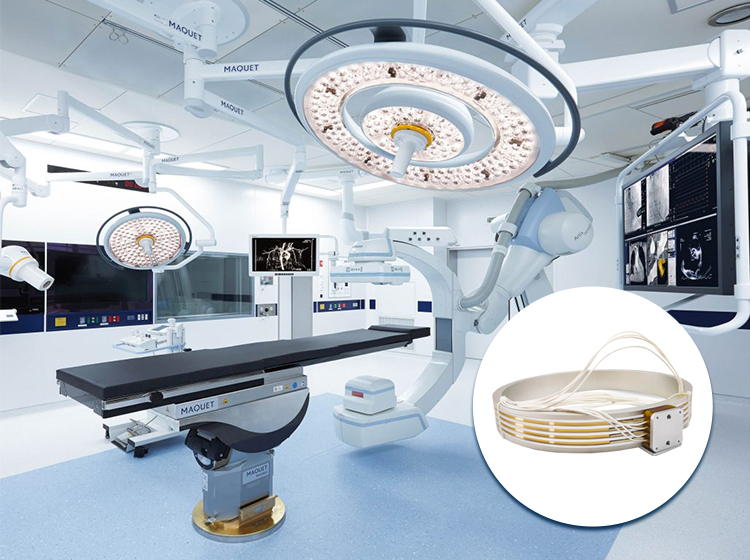
- Robotics: Facilitates precise movement control and continuous operation in industrial robots.
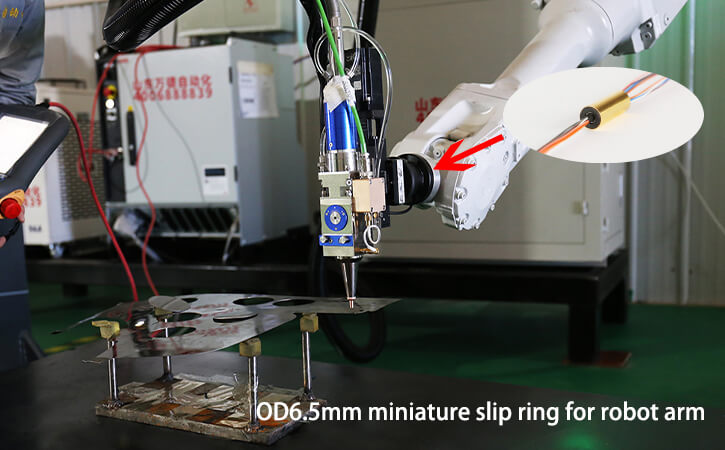
- Surveillance Systems: Provides seamless and uninterrupted video transmission in PTZ cameras, enhancing surveillance capabilities.
- Manufacturing: Improves the flexibility and efficiency of manufacturing processes by providing reliable power and signal connections to rotating tools and workpieces.

In summary, low voltage slip rings offer numerous advantages that enhance the performance, reliability, and efficiency of various rotating systems. Their continuous rotation capability, durability, versatility, and high signal integrity make them essential components in many industrial, medical, and technological applications.
Low-voltage slip rings bring substantial benefits to applications necessitating lower voltage levels, outperforming traditional counterparts in multiple ways.One of the most prominent advantages is their potential for reduced power consumption. By operating at lower voltages, these slip rings inherently draw less power, leading to energy savings over time. For organizations looking to cut back energy usage and reduce operational costs, this feature can be exceedingly advantageous.In terms of safety, low-voltage slip rings naturally carry a lower risk of electrical faults and hazards. Since they operate at lower voltages, the chance of issues such as electrical arcing, overheating, or short circuits is substantially reduced. This increased safety can lead to lower maintenance needs and can significantly improve device longevity and reliability.More compact devices often require lower voltage levels to operate, and low-voltage slip rings provide an ideal solution in such cases. Their high compatibility with smaller, intricate devices helps these devices run smoothly and ensures the interference-free exchange of data and power.However, operating at low voltages doesn’t come without challenges. One of the potential issues that may arise is the generation of heat, particularly when transmitting power over long distances or periods. The design of low-voltage slip rings, however, often mitigates this problem, integrating high-quality materials for brushes and rings that maintain low resistance and efficient power transfer.While traditional slip rings might struggle with issues such as signal degradation or increased electrical noise at lower voltages, low-voltage slip rings are specifically designed to address these problems and still offer effective performance. Their focus on maintaining signal integrity and reducing interference gives them a distinct advantage, making them ideal for applications needing reliable low-voltage operation.In summary, the advantages of low-voltage slip rings extend far beyond their core functionality, encompassing enhanced energy efficiency, increased safety, and excellent device compatibility. Despite potential challenges, their ingenious design and application-specific provisions enable them to outperform traditional slip rings in low-voltage applications.
Factors to Consider When Choosing a Low Voltage Slip Ring
Choosing the correct low-voltage slip ring requires careful consideration. The goal is to ensure electro-mechanical compatibility, reliable performance, and durability while taking into account several crucial parameters tailored to every unique situation.
First off, compatibility with your application is paramount.
It is important to consider whether the slip ring can work harmoniously with the existing electrical infrastructure and whether it matches the power or data transmission requirements. In relation to a low-voltage operation, carefully examine the rated voltage and current to make sure the slip ring is suitable.
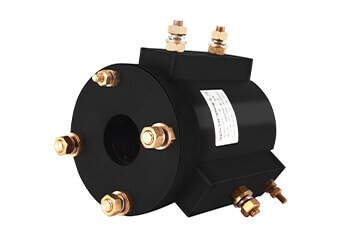
Rotational Speed is another important factor to consider.
It’s crucial to understand the desired rpm (rotations per minute) of your equipment, to ensure a compatible slip ring can handle the required speed. Generally, low-voltage slip rings are designed to accommodate a range of rotational speeds that can reach up to several thousands of rpm while maintaining minimal electrical noise.
Size matters too, especially in compact or space-constrained devices, which are often low-voltage-based.
It’s important to choose a slip ring with a suitable form factor that fits into the available space without affecting the equipment function or the slip ring’s efficiency.
Furthermore, consider the environmental conditions like temperature range, humidity, and dust.
Depending on the working environment, the slip ring may need to be built to resist harsh conditions, maintaining reliable operation at low voltage levels even under challenging circumstances.
Finally, in sourcing a low-voltage slip ring, consider partnering with a reputable supplier who specializes in low-voltage solutions.
Such manufacturers would have extensive knowledge and experience to deliver a suitable device tailored to your specific application. Check for necessary industry certifications and customer testimonials to verify the manufacturer’s credibility.
In conclusion, choosing the ideal low-voltage slip ring involves a meticulous evaluation of various parameters. By comprehensively considering compatibility, power requirements, rotational speed, environmental conditions, and device size, you can ensure the chosen slip ring matches your exact needs. Always opt for reputable manufacturers and suppliers, as this would guarantee a reliable low-voltage solution that stands up to the test of time.
User Concerns and Low Voltage Benefits
While navigating the technical landscape of low-voltage slip rings, users can often find themselves pondering over specific concerns. These can include the product lifespan, maintenance requirements, operational efficiency, and the price-quality balance. Yet, when viewed through the prism of information and understanding, low voltage slip rings stand as compelling solutions, as they can offer numerous benefits addressing these concerns.
One common apprehension users have is about the lifespan of low-voltage slip rings.
However, these devices are typically constructed with robust materials and designs that make them resistant to wear and tear, even in frequent-use scenarios. Their low voltage operation further reduces the likelihood of issues such as arcing and overheating, inherently enhancing the product’s durability.
Maintenance can be another concern for users considering low-voltage slip rings.
These devices are, however, designed for extended maintenance-free operation. The application of high-quality brushes and contact materials reduces friction, which indirectly extends the durability of these units and lowers the need for routine maintenance.
The question of operational efficiency naturally arises when considering the adoption of low-voltage slip rings.
Nevertheless, their design, which is catered towards low voltage operations, ensures minimal signal loss and electrical noise. This efficiency can lead to improved performance of the equipment they’re integrated with, making them a solid choice for enhancing operational efficacy.
When it comes to price, users may worry that lower voltage could lead to increased costs due to the need for specialized design considerations.
While low-voltage slip rings might sometimes come with a higher price tag than their high-voltage counterparts, it’s important to consider the overall cost over the device’s lifespan. With their promise of energy efficiency, safety, and durability, these slip rings often present a cost-effective solution in the long run.
In conclusion, while user concerns around low voltage slip rings are valid, the unique advantages these devices provide offer solutions to these apprehensions. With their enhanced durability, efficiency, ease of maintenance, and overall cost-effectiveness, low-voltage slip rings make a compelling case for their adoption.
Request a quote for our slip rings by providing your details in the form.
Future Trends and Developments in Low Voltage Slip Ring Technology
As we step into the future, the technological landscape continues to evolve, bringing with it interesting advancements and trends that will undoubtedly influence low-voltage slip ring technology.
One significant trend is the integration of Internet of Things (IoT) technology. Wider IoT adoption is prompting the development of more intelligent, connected slip rings capable of delivering real-time monitoring and diagnostics. In the context of low voltage slip rings, this means smarter, self-assessing units that can predict and prevent failures, increasing reliability and reducing maintenance needs.
Miniaturization is another trend reshaping the low-voltage slip ring landscape. As more compact and intricate devices needing low-voltage operation find their place in industry settings, demand is on the rise for smaller slip rings that can fit these applications without compromising the efficiency or integrity of power or signal transfer.
Enhancing energy efficiency remains a top priority globally, and this ethos seeps into slip ring technology as well. Future low-voltage slip rings will continue striving toward this goal, incorporating innovations that reduce power consumption and energy waste, ensuring a sustainable and cost-effective operation.
Impending advancements and trends, like IoT integration, miniaturization, and enhanced energy efficiency, bear significant implications for industries relying on low-voltage applications. With more intelligent, compact, and efficient devices, industries can expect a rise in operational efficiency, cost savings, and overall performance. This could revolutionize sectors like robotics, renewable energy, and aviation, where precision, compactness, and high efficiency matter immensely.
In conclusion, the future of low-voltage slip ring technology is bright – filled with promising advancements that have the potential to transform the way we harness the power of low-voltage applications. As industries brace for these changes, the potential impact of these developments could transform numerous sectors, offering new vistas of efficiency and sustainability.
See What We Can Do


